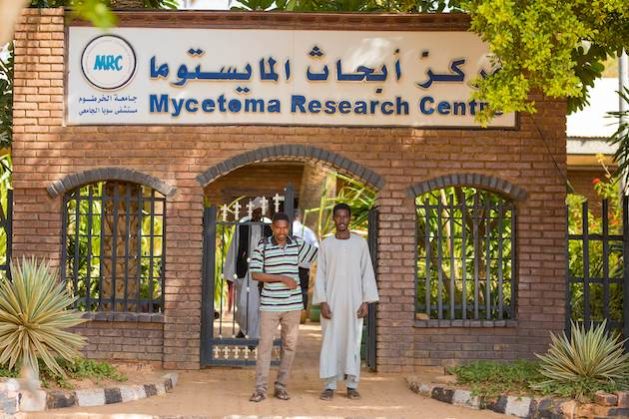Neglected Tropical Disease Mycetoma Research Gains Momentum

NAIROBI, Apr 07 (IPS) - The disease burden and distribution of mycetoma—a neglected tropical disease—are not very well understood. However, it is known to affect people in Sudan, Senegal, Mauritania, Kenya, and Niger, as well as people in Nigeria, Ethiopia, India, and Cameroon. Cases have also been reported in Djibouti, Somalia, and Yemen.
“It is currently unknown what the incidence, prevalence and the number of reported cases per year per country is,” observes Dr Borna Nyaoke, head of the Mycetoma Program at the Drugs for Neglected Diseases initiative (DNDi) – Africa Regional office. DNDi is a not-for-profit international R&D organisation operating in Kenya, Ethiopia, Uganda and Sudan.
Mycetoma is one of a group of 20 diseases referred to as neglected tropical diseases or NTDs in short. These diseases usually affect marginalized and poor communities.
NTDs are caused by viruses, bacteria, fungi and toxins from snake bites. They affect 1.7 billion people globally.
According to the Centres for Disease Control and Prevention, mycetoma is caused by certain types of bacteria and fungi found in soil and water. Mycetoma can be caused by bacteria (actinomycetoma) or fungi (eumycetoma).
For years now, little attention has been directed towards NTDs in terms of research and the development of new treatments, hence their neglected categorization status.
Between 2000 and 2014, only 66 novel products entered phase I clinical trials intended to prevent or treat NTDs, according to Dr Maurice Odiere, head of the Neglected Tropical Diseases Unit, Centre for Global Health Research at the Kenya Medical Research Institute (KEMRI). This represented just 1.65 percent of all 4,006 phase I trials in the world.
However, this has changed over the last couple of years, with concerted efforts producing new drugs and research initiatives.
For example, the world’s first randomized double-blind clinical trial on eumycetoma (fungal mycetoma) was completed last year in Sudan, according to Nyoke.
“We were comparing the investigational drug Fosravuconazole against a treatment against Itraconazole, which is the standard treatment of eumycetoma in Sudan,” she explains.
This clinical trial started in 2017 in Khartoum, Sudan, with phase II clinical trials completed in March 2022, and the top-line results were presented in September 2022. The clinical report is under review and is expected to be finalized later in 2023.
The study was conducted in Sudan because it is one of the countries where mycetoma is endemic.
Expensive Toxic Treatment
The existing treatments for eumycetoma, such as the antifungals Ketoconazole and Itraconazole, are expensive, ineffective, and have serious side effects. Patients oftentimes undergo multiple amputations, which may prove fatal.
However, scientists think that Fosravuconazole, a drug developed for onychomycosis (a fungal nail infection), could offer an effective and affordable treatment for eumycetoma, hence the study. The drug’s interaction with body tissues is said to be favourable, and its toxicity levels are low. Lab tests show its activity against agents causing eumycetoma to be effective.
Mohamed Safi Ahmed El-Safi, who hails from the Kordofan region of Sudan, is a survivor of mycetoma. Initially, he did not think much of what appeared to be a pimple on his toe.
However, he would soon seek medical attention when he began experiencing excruciating pain emanating from the toe.
“The infection and pain increased, giving me a fever. My body felt like I was on fire,” recounts El-Safi.
Medical tests later revealed that the infection had spread to the bone. His lower right leg had to be amputated as a result. He now urges people to immediately seek medical attention once they notice a boil or pimple on the leg.
Mycetoma Research Centre (MRC)
Sudan boasts of the Mycetoma Research Centre (MRC) in Khartoum, which was established in 1991 under the auspices of the University of Khartoum, which is based at Soba University Hospital.
“It is the only referral hospital in the country, providing integrated medical care for mycetoma patients as well as training for medical and health professionals,” says Nyaoke.
Not only does the centre receive patients from within Sudan, patients from across Africa and the Middle East are referred to the Centre as well.
Nyaoke maintains that plans are underway to conduct epidemiological studies in Sudan, Senegal and India, among other endemic countries, to gather information on the burden and distribution of disease.
IPS UN Bureau Report
Follow @IPSNewsUNBureau
Follow IPS News UN Bureau on Instagram
© Inter Press Service (2023) — All Rights Reserved. Original source: Inter Press Service
Where next?
Browse related news topics:
Read the latest news stories:
- Latin America & the Caribbean in 2024: Renewable Energy and Early Warning Systems Offer Hope Amid Climate Extremes Friday, March 28, 2025
- Marley, Music, Morris, Life: A Photo Voyage in Paris Friday, March 28, 2025
- The Giant Plastic Tap: How art fights plastic pollution Friday, March 28, 2025
- UNICEF Report Warns of Rising Rates of Child Mortality without Proper Funding Friday, March 28, 2025
- Building Resilience in Least Developed Countries – A Pathway to Sustainable Transformation Friday, March 28, 2025
- ‘Perfect storm’ in South Sudan demands urgent action, says Guterres Friday, March 28, 2025
- 47 million health workers and advocates call for cleaner air to curb pollution deaths Friday, March 28, 2025
- Gaza: Acts of war bear hallmarks of atrocity crimes, warn UN humanitarians Friday, March 28, 2025
- UN teams ramp up response to deadly quake in Myanmar and Thailand Friday, March 28, 2025
- Extreme weather impacts cascading ‘from the Andes to the Amazon’ Friday, March 28, 2025